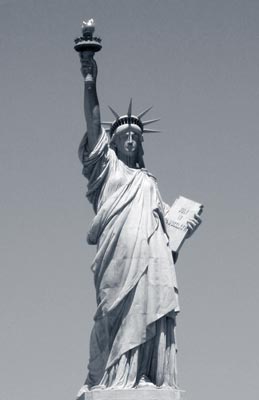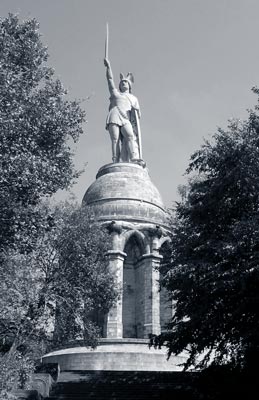

Guided by . . . the knowledge that there are laws; that . . . that which is within flows outward upon a design; that life precipitates itself through human affairs as it does through the forms of the crystals; that there is nothing more haphazard about the sequence of empires and civilizations, than there is about the unfolding of petals of a flower. In both cases it is the eternal rhythm, the Poetry of the Infinite, that manifests; our business is to listen so carefully as to hear, and apprehend the fact that what we hear is a poetry, a vast music, not a chaotic cacophony: catch the rhythms — perceive that there is a design — even if it takes us long to discover what the design may be. — Kenneth Morris
There are two Statues of Liberty, each visited by millions of people every year. We all know the one in New York Harbor designed by Frederic Auguste Bartholdi, and given by the French people to the citizens of the United States. Since 1886 she has stood in solitude on her small island, welcoming vessels that come to visit the new world. She has something of Prometheus about her, holding her torch high to show there is light to share, a beacon of hope and thought. Through this light we know she does not merely represent selfish, isolated freedom but liberty as emancipation of self by acquiring knowledge and wisdom.
Then there is another "Statue of Liberty" across the Atlantic, located southwest of Detmold in the Teutoburg Forest. A heroic German warrior from the Roman era lifts his sword to the sky, standing high and proud atop one of the westernmost ridges of Germany, looking west. This Hermannsdenkmal (Hermann Memorial) by Ernst von Bandel was a present of the German public to Kaiser Wilhelm I to commemorate the Germanic victory by war chief Arminius or Hermann over the Romans in 9 CE which assured that most Germanic tribes escaped Roman domination. Consecrated on August 16, 1875 — the same year that the Theosophical Society was founded in New York City — it is eleven years the senior of the Statue of Liberty.


In many respects the Hermannsdenkmal warrior mirrors the mighty goddess of New York. Constructed similarly, they are of huge proportions: the Statue of Liberty stands 46 meters tall on a 47 meter pedestal, while the statue of Hermann stands 27 meters tall on a 31 meter base. While each certainly has political and national dimensions, looking deeper we can see something more, two related though distinct messages: while the Statue of Liberty calls for wisdom and brotherhood, the German statue celebrates victory and unity, radiating willpower and courage reminiscent of the warrior in Reginald Machell's painting The Path.
In this age of worldwide travel, satellites, and the internet, these statues stand much closer together than at the time of their making. We can even imagine them uniting in spirit to form a complementary couple greeting each other across the Atlantic. Together they reveal the best of male and female qualities, reminding us that we need to master both. Heroism, willpower, sound judgment, love, and wisdom: all these qualities are needed to conquer ourselves.
These statues also imply that there exists an unseen connection between continents, even those divided by great distances. In the same way there is a void between wisdom and brute force that must be crossed. This void exists between each of us and our real inner parent, our higher self, the one who is always one step ahead of us, who arranges our new birth and welcomes us when we die. As we approach the discovery of our true self in this life, we can draw on the qualities symbolized by these two statues to help us achieve this high goal.
(From Sunrise magazine, February/March 2006; copyright © 2006 Theosophical University Press)